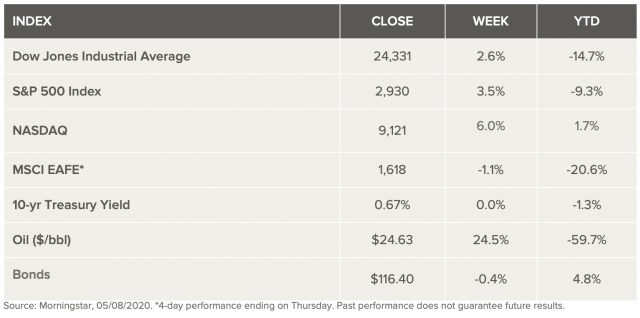Stock Markets
Stocks finished higher last week, with energy and technology stocks leading the way. Oil recorded its first back-to-back weekly gain since February, as oil companies are cutting production faster than expected and as signs of increased demand emerged. On the economic front, the April employment report showed that a record 20.5 million jobs were lost last month, erasing roughly all the jobs that the economy had added in this past decade’s expansion. The silver lining was that 80% of the job losses were reported as temporary layoffs. The S&P 500 has now recouped about half its losses from the record high earlier in the year on hopes that economic activity may be bottoming as restrictions ease and economies reopen. We think that a recovery will take shape, but there will be bumps along the way.
U.S. Economy
The week brought a host of data showing an unprecedented contraction in economic activity, but investors seemed to take hope that the economy was bottoming. On Tuesday, several gauges showed a record contraction in both manufacturing and services activity in April, but the Institute for Supply Management’s non-manufacturing purchasing managers’ index fell much less than feared. On Thursday, stocks rose despite the Labor Department’s report of another 3.2 million Americans filing for unemployment insurance in the previous week, with investors apparently reassured that this marked the fifth straight weekly decline in the number of initial jobless claims.
Metals and Mining
Gold continued its ascent above US$1,700 per ounce this week, driven by continued weak economic data and massive job losses. Gaining 1.7 percent week-over-week, the yellow metal dipped to US$1,684.10 on Wednesday before rebounding 2.4 percent to reach US$1,724.80 in pre-trading hours on Friday. While the rest of the precious metals were a mixed bag, the broader base metals market made significant gains this period as Chinese demand began to increase again.
Since breaking past US$1,700 on May 1, gold has retained its worth save for a brief two-day period this week, which saw the currency metal slip — offering a value opportunity for those interested to get in. Soaring unemployment numbers in the US, which recorded 22 million job losses in April, were compounded by almost 2 million lost jobs in Canada, helping to push gold above US$1,720 on Friday. Despite that dismal data, gold exchange-traded funds (ETFs) have continued to make historic gains. In April, gold-backed ETFs added 170 tonnes, increasing holdings to 3,355 tonnes, an all-time high. Gold’s safe haven nature could be tested in the coming weeks as there is speculation that the US Federal Reserve may announce another round of economic stimulus measures. Silver also made positive moves on Friday, climbing as high as US$15.62 per ounce for the first time since mid-March, before the rush to cash drove commodities lower. Platinum squeaked out a modest week-over-week gain. Mine closures in South Africa — the leader in output — are likely to lead to supply constraints later in the year, setting the stage for a potential shortage, according to a note from Bank of America Merrill Lynch. As mentioned, mine closures have also impacted the palladium space, and could lead to potential price growth later in the year as stores of the metal deplete. In the meantime, the autocatalyst metal is feeling pressure from broken supply chains and weak automotive sales, both of which impeded any growth this week. Starting the session at US$1,832 per ounce, palladium fell as low US$1,691 this week before clawing its way back above US$1,700. After hitting an all-time high of US$2,754 in late February, the metal has lost over 35 percent of its value.
In the base metals space, copper has made a week of straight gains as Chinese demand for the unwrought metal grew by 4.4 percent month-over-month to 460,000 tonnes in April. The value of the base metal increased 3.3 percent for week. Promise that the need for the red metal will climb as countries emerge from current situations bodes well for prices. Zinc also edged higher in Friday’s session, adding 6.2 percent to its value. Recent activity has been driven by rising demand for zinc futures on Chinese markets. Nickel surged ahead this week by over 4 percent, rising from US$11,785 per tonne on Monday to US$12,224 on Thursday. Demand from Asian nations propelled nickel futures higher. While the news is good for the versatile metal, it is still well off its year-to-date high of US$14,285, reached in mid-January. In the lead space, prices also trended higher, starting the session at US$1,592.50 per tonne and ticking up to US$1,619.50. The catalyst driving the other base metals also motivated lead.
Energy and Oil
Oil rally may be going too far. Oil prices have doubled in a little more than a week on mounting supply shut-ins and hopes of a demand rebound. But analysts are warning that the newfound optimism is premature. “Even following a gradual resumption of economic activity, demand may remain below the 2019 level for years to come,” Commerzbank analysts said. U.S. and Canadian oil production is on track to decline by 1.7 mb/d by the end of June, according to Reuters. “When prices went negative it really accelerated some of the cuts,” Allyson Cutright, director at Rapidan Energy Group, told the media. In addition, frac sand mines are closing down, laying off workers and cutting output. “The obvious answer,” Blake Gendron, an oilfield analyst with Wolfe Research, told the media “is rapid consolidation.”
In a turn on the energy front, Middle East oil producers are looking to renewables. “Solar power is the cheapest kilowatt-hour in the Middle East,” Benjamin Attia, an analyst at Wood Mackenzie, said. Solar can meet most of the electricity demand growth going forward in much of the Middle East. Globally, renewable deals are still moving forward despite the crisis in energy markets. The IEA said that renewables will be the only source of energy to grow this year. “I’m feeling strangely positive because I’m in renewables. If I was in chemicals or aviation or shipping, then I wouldn’t be,” Mortimer Menzel, a partner at Augusta and Co, a clean energy advisory firm, told the media.
Natural gas spot price movements increased this week. The Henry Hub spot price rose from $1.70 per million British thermal units (MMBtu) last week to $1.88/MMBtu this week. At the New York Mercantile Exchange (Nymex), the price of the June 2020 contract increased 8¢, from $1.869/MMBtu last week to $1.944/MMBtu to this week. The price of the 12-month strip averaging June 2020 through May 2021 futures contracts climbed 2¢/MMBtu to $2.557/MMBtu.
World Markets
Equities in Europe reversed course and ended higher amid late signs of easing U.S.-China tensions and optimism that economies would start to recover as lockdown restrictions are lifted. The pan-European STOXX Europe 600 Index rose 0.92%. The main country indexes, however, were mixed. Germany’s Xetra DAX Index ended up 0.24%, France’s CAC 40 slipped 0.59%, and Italy’s FTSE MIB Index dropped 1.84%. The UK’s FTSE 100 Index, which was closed on Friday for a public holiday, rose 3% after an unexpected increase in Chinese exports fueled hopes for a quick economic recovery.
In a holiday-shortened week, China A-shares resumed their gradual uptrend on Wednesday. The Shanghai Composite and CSI 300 large-cap indices both finished up around 1.25% from their pre-holiday April 30 close.
The public health risks in China continue to fade rapidly. All of China’s provinces have downgraded their emergency threat levels to Level II or below. Ahead of key college entrance examinations in early July, all provinces have reopened their high schools to graduating students. The National People’s Congress (NPC) is also confirmed to open on May 21 in Beijing, with over 5,000 delegates attending in person. In an effort to calm rising trade tensions, Vice Premier Liu He spoke with U.S. Trade Representative Robert Lighthizer and Treasury Secretary Steven Mnuchin on Friday, according to China’s official press agency. During the discussion, they reportedly reaffirmed their commitment to an initial trade deal reached in January and pledged to improve cooperation between the two nations.
The Week Ahead
Important economic data being released include inflation on Tuesday and consumer sentiment and retail sales on Friday.
Key Topics to Watch
- NFIB small-business index
- Consumer price index
- Core CPI
- Federal budget
- Producer price index
- Initial jobless claims
- Import price index
- Retail sales
- Retail sales ex-autos
- Empire state index
- Industrial production
- Capacity utilization
- Job openings
- Consumer sentiment index
- Business inventories
Markets Index Wrap Up


